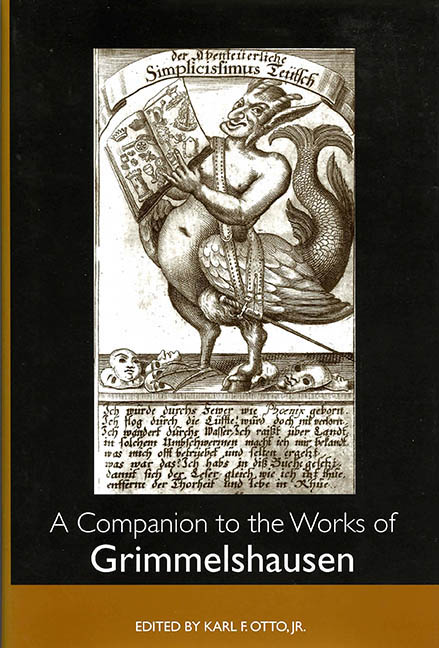Book contents
- Frontmatter
- Contents
- Illustrations
- Acknowledgments
- Chronological List of Grimmelshausen's Works and Their First English Translation
- Introduction
- I Basics
- Problems in the Editions of Grimmelshausen's Works
- Grimmelshausen's “Autobiographies” and the Art of the Novel
- Allegorical and Astrological Forms in the Works of Grimmelshausen with Special Emphasis on the Prophecy Motif
- Grimmelshausen and the Picaresque Novel
- Grimmelshausen's Ewig-währender Calender: A Labyrinth of Knowledge and Reading
- Grimmelshausen's Non-Simplician Novels
- In Grimmelshausen's Tracks: The Literary and Cultural Legacy
- II Critical Approaches
- Notes on the Contributors
- Index
Grimmelshausen's Ewig-währender Calender: A Labyrinth of Knowledge and Reading
from I - Basics
Published online by Cambridge University Press: 27 April 2017
- Frontmatter
- Contents
- Illustrations
- Acknowledgments
- Chronological List of Grimmelshausen's Works and Their First English Translation
- Introduction
- I Basics
- Problems in the Editions of Grimmelshausen's Works
- Grimmelshausen's “Autobiographies” and the Art of the Novel
- Allegorical and Astrological Forms in the Works of Grimmelshausen with Special Emphasis on the Prophecy Motif
- Grimmelshausen and the Picaresque Novel
- Grimmelshausen's Ewig-währender Calender: A Labyrinth of Knowledge and Reading
- Grimmelshausen's Non-Simplician Novels
- In Grimmelshausen's Tracks: The Literary and Cultural Legacy
- II Critical Approaches
- Notes on the Contributors
- Index
Summary
Introduction to the Work and Previous Research
With regard to its conception and uniqueness, Grimmelshausen's Ewig-währender Calender is probably the least acknowledged work of the author. For quite some time, even up to the 1990s, the work has been viewed only as a collection of “calendar stories.” Jan Rohner and Ludwig Knopf had devoted studies to the work in the 1970s and 1980s, but they also analyzed the work chiefly as “calendar stories,” that is, as short, entertaining stories that pretended to be true and were published in calendars. They, and many other scholars as well, saw Grimmelshausen's calendar as a by-product of Simplicissimus, the most important novel of the author (Berns, 1994, 23). Only in the last few years, due in large part to the workshop conducted by Jörg Jochen Berns in 1994, which was dedicated solely to the calendar, has it become clear that we are really dealing with an independent literary work with its own organizational principles.
It would be useful before proceeding to a study of Grimmelshausen's calendar to look at calendars in general in the seventeenth century. Calendars had been, of course, widely distributed ever since the invention of the printing press, particularly in rural areas. It goes beyond the scope of this presentation to trace the whole history of printed calendars.However, let us at least look at the various types of calendars which probably served as a background, even as a basis for Grimmelshausen's Ewig-währender Calender. There are four types that have to be mentioned: martyrologies, continuous calendars, farmer's almanacs, and annual calendars. The martyrologies provide a complete list of saints to be honored on every day of the year; they have primarily an ecclesiastical audience. Those who used this kind of calendar most frequently were certainly not the laity (even though they were written in German), but rather the priests. The priests had to know, for example, on which day of the year the patron saint of the parish or of the numerous chapels within the parish was to be honored. The names of certain saints who were of greater than regional importance were, in the martyrologies as in other calendars, printed in red. They were celebrated at the national, or international, level and also served to orient the farmers with regard to agricultural tasks such as planting.
- Type
- Chapter
- Information
- A Companion to the Works of Grimmelshausen , pp. 167 - 200Publisher: Boydell & BrewerPrint publication year: 2002



